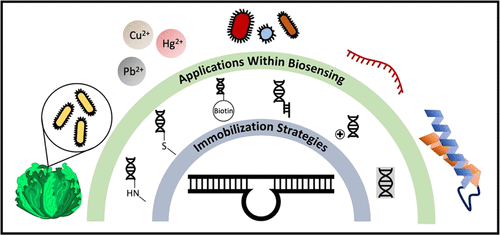Our official English website, www.x-mol.net, welcomes your
feedback! (Note: you will need to create a separate account there.)
DNAzyme-Based Biosensors: Immobilization Strategies, Applications, and Future Prospective
ACS Nano ( IF 15.8 ) Pub Date : 2021-09-15 , DOI: 10.1021/acsnano.1c04327 Shadman Khan 1 , Brenda Burciu 2 , Carlos D M Filipe 3 , Yingfu Li 4 , Kristen Dellinger 2 , Tohid F Didar 1, 5
ACS Nano ( IF 15.8 ) Pub Date : 2021-09-15 , DOI: 10.1021/acsnano.1c04327 Shadman Khan 1 , Brenda Burciu 2 , Carlos D M Filipe 3 , Yingfu Li 4 , Kristen Dellinger 2 , Tohid F Didar 1, 5
Affiliation

|
Since their discovery almost three decades ago, DNAzymes have been used extensively in biosensing. Depending on the type of DNAzyme being used, these functional oligonucleotides can act as molecular recognition elements within biosensors, offering high specificity to their target analyte, or as reporters capable of transducing a detectable signal. Several parameters need to be considered when designing a DNAzyme-based biosensor. In particular, given that many of these biosensors immobilize DNAzymes onto a sensing surface, selecting an appropriate immobilization strategy is vital. Suboptimal immobilization can result in both DNAzyme detachment and poor accessibility toward the target, leading to low sensing accuracy and sensitivity. Various approaches have been employed for DNAzyme immobilization within biosensors, ranging from amine and thiol-based covalent attachment to non-covalent strategies involving biotin–streptavidin interactions, DNA hybridization, electrostatic interactions, and physical entrapment. While the properties of each strategy inform its applicability within a proposed sensor, the selection of an appropriate strategy is largely dependent on the desired application. This is especially true given the diverse use of DNAzyme-based biosensors for the detection of pathogens, metal ions, and clinical biomarkers. In an effort to make the development of such sensors easier to navigate, this paper provides a comprehensive review of existing immobilization strategies, with a focus on their respective advantages, drawbacks, and optimal conditions for use. Next, common applications of existing DNAzyme-based biosensors are discussed. Last, emerging and future trends in the development of DNAzyme-based biosensors are discussed, and gaps in existing research worthy of exploration are identified.
中文翻译:

基于 DNAzyme 的生物传感器:固定化策略、应用和未来前景
自从他们在大约三年前发现以来,DNAzyme 已被广泛用于生物传感。根据所使用的 DNAzyme 的类型,这些功能性寡核苷酸可以作为生物传感器内的分子识别元件,为其目标分析物提供高特异性,或作为能够转导可检测信号的报告基因。在设计基于 DNAzyme 的生物传感器时需要考虑几个参数。特别是,鉴于许多这些生物传感器将 DNAzymes 固定在传感表面上,选择合适的固定策略至关重要。次优的固定会导致 DNAzyme 脱离和对目标的可及性差,从而导致低传感精度和灵敏度。各种方法已被用于生物传感器内的 DNAzyme 固定,从基于胺和硫醇的共价连接到涉及生物素-链霉亲和素相互作用、DNA 杂交、静电相互作用和物理捕获的非共价策略。虽然每种策略的特性都表明其在建议的传感器中的适用性,但适当策略的选择在很大程度上取决于所需的应用。考虑到基于 DNAzyme 的生物传感器用于检测病原体、金属离子和临床生物标志物的多种用途,这一点尤其正确。为了使此类传感器的开发更易于导航,本文全面回顾了现有的固定策略,重点介绍了它们各自的优点、缺点和最佳使用条件。接下来,讨论了现有基于 DNAzyme 的生物传感器的常见应用。最后的,
更新日期:2021-09-28
中文翻译:

基于 DNAzyme 的生物传感器:固定化策略、应用和未来前景
自从他们在大约三年前发现以来,DNAzyme 已被广泛用于生物传感。根据所使用的 DNAzyme 的类型,这些功能性寡核苷酸可以作为生物传感器内的分子识别元件,为其目标分析物提供高特异性,或作为能够转导可检测信号的报告基因。在设计基于 DNAzyme 的生物传感器时需要考虑几个参数。特别是,鉴于许多这些生物传感器将 DNAzymes 固定在传感表面上,选择合适的固定策略至关重要。次优的固定会导致 DNAzyme 脱离和对目标的可及性差,从而导致低传感精度和灵敏度。各种方法已被用于生物传感器内的 DNAzyme 固定,从基于胺和硫醇的共价连接到涉及生物素-链霉亲和素相互作用、DNA 杂交、静电相互作用和物理捕获的非共价策略。虽然每种策略的特性都表明其在建议的传感器中的适用性,但适当策略的选择在很大程度上取决于所需的应用。考虑到基于 DNAzyme 的生物传感器用于检测病原体、金属离子和临床生物标志物的多种用途,这一点尤其正确。为了使此类传感器的开发更易于导航,本文全面回顾了现有的固定策略,重点介绍了它们各自的优点、缺点和最佳使用条件。接下来,讨论了现有基于 DNAzyme 的生物传感器的常见应用。最后的,











































 京公网安备 11010802027423号
京公网安备 11010802027423号